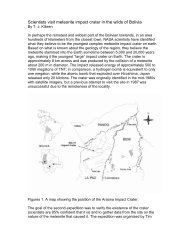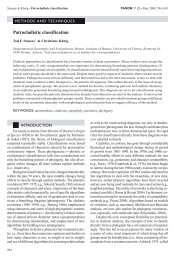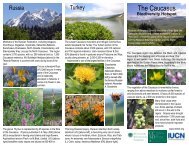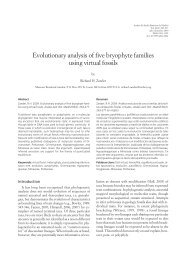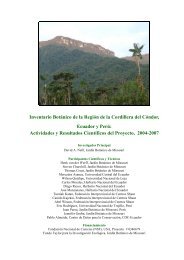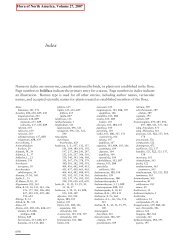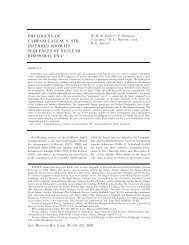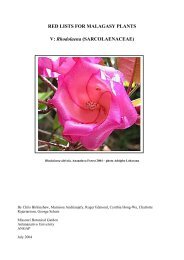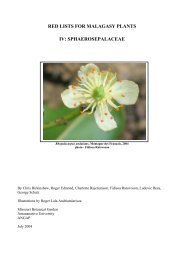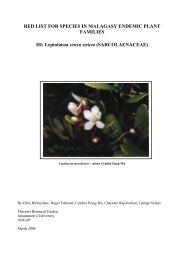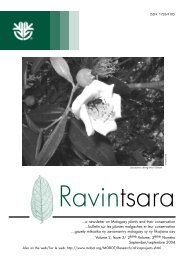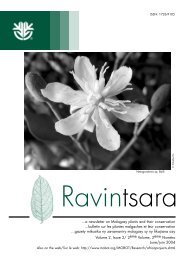re-evaluation of tortella - Missouri Botanical Garden
re-evaluation of tortella - Missouri Botanical Garden
re-evaluation of tortella - Missouri Botanical Garden
You also want an ePaper? Increase the reach of your titles
YUMPU automatically turns print PDFs into web optimized ePapers that Google loves.
Weissiodicranum and Weisiopsis, far from its traditional<br />
grouping in the Trichostomoideae. An important aspect<br />
<strong>of</strong> the new arrangement is the grouping <strong>of</strong> genera,<br />
including Weissia, with others that have bulging cells on<br />
the adaxial surface <strong>of</strong> the leaf <strong>re</strong>lative to the flat abaxial<br />
surface.<br />
As for Weissia jamaicensis, we<strong>re</strong> this species<br />
<strong>re</strong>moved from that genus and placed instead in a group<br />
<strong>of</strong> taxa, such as the Chionolomoideae (Zander 1993),<br />
comprised <strong>of</strong> Chionoloma, Pseudosymblepharis and<br />
Pachyneuropsis, genera with many morphological and<br />
possibly distributional characteristics sha<strong>re</strong>d by this<br />
species, the genus Weissia may display a mo<strong>re</strong> natural<br />
distance from the Trichostomoideae. Unlike many<br />
species in the genus Weissia, W. jamaicensis is<br />
dioicous, it has a massive adaxial ste<strong>re</strong>id band c<strong>re</strong>ating a<br />
strongly convex adaxial pr<strong>of</strong>ile in section, an elongate<br />
leaf, such as others in the Chionolomoideae, and other<br />
characteristics that a<strong>re</strong> suggestive <strong>of</strong> a diffe<strong>re</strong>nt<br />
placement <strong>of</strong> this species.<br />
One rather distinctive characteristic <strong>of</strong> the<br />
genus Tortella is the flattened, foliose, stalked<br />
perigonial buds <strong>of</strong> some species. Only one <strong>of</strong> the taxa<br />
he<strong>re</strong> studied possesses them: Tortella humilis. The<strong>re</strong> is,<br />
however, a group <strong>of</strong> species <strong>of</strong> the genus that exhibit<br />
this character, listed by Brotherus (1924–25). The<strong>re</strong> a<strong>re</strong><br />
species in the genus Trichostomum with these, such as<br />
Trichostomum fragilifolium Dix., and Trichostomum<br />
spirale Grout, and at least St<strong>re</strong>ptocalypta tortelloides<br />
(Card.) Zand., <strong>of</strong> the four species <strong>re</strong>cognized for that<br />
genus (Zander 1993), also has them. Again, in the genus<br />
Plerurochaete, whe<strong>re</strong> all the species a<strong>re</strong> dioicous, the<br />
perigonia (and perichaetia) a<strong>re</strong> <strong>re</strong>gularly stalked. These<br />
genera in the Trichostomoideae may be <strong>re</strong>lated by this<br />
tangential similarity, perhaps through a <strong>re</strong>duction series<br />
in the peristome.<br />
In the following t<strong>re</strong>atment, g<strong>re</strong>at emphasis has<br />
been put on the cross section <strong>of</strong> the distal <strong>re</strong>gion <strong>of</strong> the<br />
leaf in delimiting taxa and for discussing <strong>re</strong>lationships.<br />
Although some bryologists do not ca<strong>re</strong> to employ this<br />
technique, nor a<strong>re</strong> stem and leaf sections <strong>of</strong>ten<br />
conside<strong>re</strong>d to be significant in determining taxonomic<br />
limits at the species level, yet details about these<br />
characters we<strong>re</strong> employed to assess the concepts <strong>of</strong><br />
earlier students. It was found during the course <strong>of</strong> this<br />
study that these characters do in fact aid in identification<br />
<strong>of</strong> specimens.<br />
Some <strong>re</strong>cent floristic t<strong>re</strong>atments <strong>of</strong> the genus<br />
have tended to group species with mo<strong>re</strong> or less ligulate<br />
leaves and obtuse apices as seg<strong>re</strong>gated from those with<br />
lanceolate leaves. In the p<strong>re</strong>sent study, Tortella humilis<br />
is p<strong>re</strong>sumed to be associated with T. flavovi<strong>re</strong>ns and T.<br />
nitida on the basis <strong>of</strong> the strong stem central strand, the<br />
variously gradually diffe<strong>re</strong>ntiated proximal cells, with a<br />
border <strong>of</strong> elongated, smooth, thin-walled and lax cells<br />
mo<strong>re</strong> or less confined to the border in some or all<br />
leaves. This characteristic set, together with the stalked<br />
perigonial bud <strong>of</strong> T. humilis seems to associate the<br />
group with the genus Plerurochaete as noted above, but<br />
also with Trichostomum, some species <strong>of</strong> which have a<br />
3<br />
hint <strong>of</strong> a marginal border and some have stalked<br />
perigonial buds. The somewhat <strong>re</strong>duced peristome with<br />
e<strong>re</strong>ct teeth also suggests that last genus as do the<br />
undiffe<strong>re</strong>ntiated perichaetial leaves. St<strong>re</strong>ptocalypta has a<br />
<strong>re</strong>duced peristome and stalked perigonial buds in one <strong>of</strong><br />
the th<strong>re</strong>e species, and undiffe<strong>re</strong>ntiated perichaetial<br />
leaves.<br />
Tortella alpicola, hitherto discussed (see<br />
below) as <strong>re</strong>lated to or as a variety <strong>of</strong> T. tortuosa or T.<br />
fragilis, actually is distinguished by the consistent<br />
p<strong>re</strong>sence <strong>of</strong> a stem central strand. The absence or poor<br />
development <strong>of</strong> an adaxial ste<strong>re</strong>id band in the leaf seems<br />
to suggest St<strong>re</strong>ptocalpyta; this characteristic, however,<br />
also applies to the var. fragilifolia <strong>of</strong> Tortella tortuosa.<br />
The perichaetial leaves a<strong>re</strong> the same as those <strong>of</strong> T.<br />
tortuosa. I shall speculate that Tortella alpicola will<br />
prove to have a nearly cosmopolitan distribution and in<br />
fact be <strong>re</strong>latively ancestral to a T. tortuosa complex.<br />
One need only <strong>re</strong>fer to the large number <strong>of</strong> infraspecific<br />
taxa accorded to T. tortuosa in Europe to posit such a<br />
complex. The literatu<strong>re</strong> <strong>of</strong> T. alpicola seems to imply<br />
that it is a <strong>re</strong>latively <strong>re</strong>cent species when in fact it may<br />
be one <strong>of</strong> the mo<strong>re</strong> ancient in the Tortella group.<br />
The fact that Tortella tortuosa in the enti<strong>re</strong><br />
North American continent, including Mexico, can be<br />
accorded only two varieties, one in the ext<strong>re</strong>me north<br />
(Arctic) or at ext<strong>re</strong>mely high altitudes and the other only<br />
a vaguely defined entity associated with moderately<br />
high elevations in the Temperate-Bo<strong>re</strong>al zone, might be<br />
useful in distinguishing species limits in what appears to<br />
be a welter <strong>of</strong> intergrading forms in Europe. Tortella<br />
fragilis may be conside<strong>re</strong>d a derived form <strong>of</strong> Tortella<br />
tortuosa through the variety fragilifolia along the lines<br />
conceived by Dixon (1924).<br />
Another group <strong>re</strong>lated to Tortella tortuosa<br />
through diffe<strong>re</strong>ntiated perichaetial leaves, absence <strong>of</strong> a<br />
stem central strand, sharply distinguished V-shape to the<br />
proximal cell <strong>re</strong>gion, and long, spirally twisted<br />
peristome, may be Tortella inclinata, T. densa (he<strong>re</strong><br />
t<strong>re</strong>ated as varieties <strong>of</strong> T. inclinata) and T. rigens. It has<br />
been speculated that Tortella rigens may sha<strong>re</strong> some <strong>of</strong><br />
the genes <strong>of</strong> T. fragilis (see discussion below).<br />
Tortella inclinata var. densa has not been<br />
<strong>re</strong>ported for the North American flora, while T. rigens<br />
has but based on erroneous and p<strong>re</strong>matu<strong>re</strong><br />
determinations. The concept <strong>of</strong> these two taxa and <strong>of</strong><br />
Tortella inclinata employed <strong>re</strong>cently by Crundwell and<br />
Nyholm in various publications (particularly Crundwell<br />
& Nyholm 1962; Nyholm 1989) does not fit exactly<br />
with North American material in some <strong>re</strong>spects, but<br />
seems to be the most useful to explain the p<strong>re</strong>sence and<br />
distribution <strong>of</strong> these th<strong>re</strong>e taxa and their substrates in the<br />
<strong>re</strong>gion.<br />
In consideration <strong>of</strong> the glacial-geological<br />
implications <strong>of</strong> the substrates <strong>of</strong> these th<strong>re</strong>e taxa in the<br />
North American situation, one might speculate that<br />
plants <strong>of</strong> Tortella inclinata var. densa that occur in<br />
upland (rock c<strong>re</strong>vices) situations might be associated<br />
with glacial <strong>re</strong>fugia (or at least mo<strong>re</strong> stable habitats),<br />
Tortella inclinata var. inclinata with the constantly





